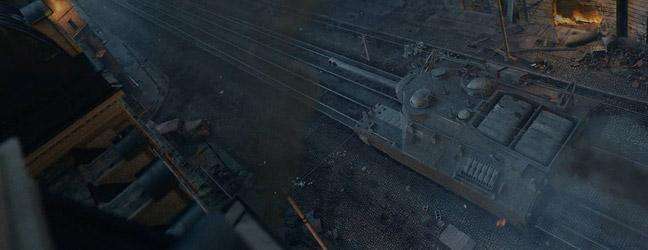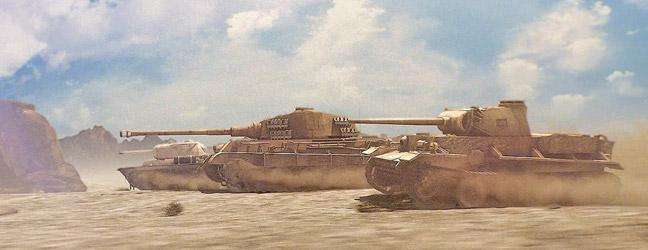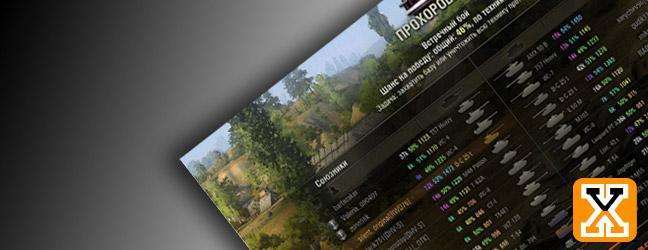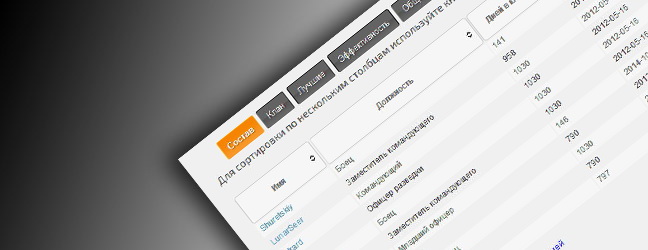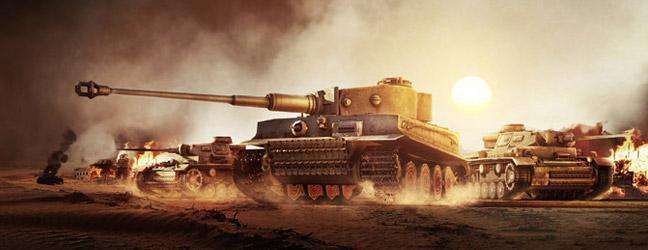Your Ideal Tank Contest
Дата: 12.03.2010 05:54:12
MrVic: Panzerkampfwagen III/40
Known as (Panzer III/40)
Nicknamed: (“Das Hornet”)

Panzer II/40’s Origin
Panzer III/40 was the product of the war torn experiences of Wilhelm Ziemann. In 1938 Wilhelm Ziemann was part of
the invasion of Poland in September 1939. During the first weeks of the invasion Wilhelm Ziemann’s tank was
overwhelmed by infantry and disabled. Thanks to the fast response of other Panzer IIs in his platoon he escaped
with no injuries. A week later in his repaired Panzer II he was back in action. Only 2 days after rejoining his
platoon his Panzer was hit by a Polish kb ppanc wz. 35 Anti-Tank rifle. The round pierced a fuel line and a fire
broke out in the tank. Scrambling to escape the fire and smoke filled panzer he got hung up on part of the turret
basket attempting to climg free. Out of the smoke a man wearing a german uniform with no rank or units pins pulled
him free and off the tank. Ziemann passed out upon hitting the ground outside the tank and awoke in a field hospital,
where he was being prepared for transport. Ziemann’s crew was killed in the fire and Ziemann himself suffered
second and some third degree burns over 20% of his body. Ziemann was shipped back to Germany to recuperate and heal.
In the same battle was the German civilian engineer Derk Herwig. Herwig had been at the battle as an observer to
help assess the combat weaknesses of the current German armored forces. Herwig was currently part of the design
team working on various secret panzer development projects. Herwig suffered minor burns and took a rifle round to
the leg the same day Ziemann’s Panzer was hit.
In an ironic twist of fate both were shipped to the same hospital behind the lines in Germany. As they both healed
they crossed paths in the hospital and became rather good friends. Neither really spoke of the battle the first few
times they talked. Then Ziemann broke down into a rant about German issues with the current panzers and the possibility
of facing the higher firepower and heavy armor of the French tanks. In sudden realization that Herwig had told him
earlier he was a civilian engineer and that he also had been injured at the same battle in Poland. Ziemann questioned why
a civilian engineer would have been there to begin with. Herwig explained his goal during the battle and that he was part
of a team working on secret panzer variants to be approved by the Führer in the coming months. Herwig being a humble man,
knew that he was the unknown man that pulled Ziemann to safety during the battle. Herwig also never told anyone about his
selfless act of bravery.
After a few weeks of talk Herwig had it arranged for Ziemann to come and evaluate the new panzer concepts. At the factory
Ziemann immediately found a tank he could work with. It was to be the precursor to the Hetzer that was developed years later.
The Panzer III/40 prototype was not complete yet but the main gun had been selected from a version designed during the
early development of the PaK 40. The birth of the Pak 40 was in 1939 with development contracts being placed with Krupp and
Rheinmetall to develop a 7.5 cm anti-tank gun. The one the Panzer III/40 would use was a bulkier early model that was being
considered for production in early 1940. Ziemann was approving of the armor upgrades though he was unsure about the
effectiveness of the sleek angular sides.
The biggest concern Ziemann had was defense against infantry advances and assaults. More than likely due to his injuries and
lost crew to infantry attacks. As the Prototype was designed it lacked much in the way of weapons to deter or stop a determined
infantry unit from advancing and destroying or disabling the panzer. Herwig quickly came up with a possible solution.
Lengthening the superstructure of the tank and installing a Panzer II turret with a 20mm KwK 38 L/55 and a 1 x 7.92 MG34 (coaxial).
With the tank commander able to man the position as they did in Panzer IIs while being able to bring they turret to bear on
thin skinned targets or infantry. This also reduced the crew requirement by 1 and help preserve space for ammunition and the
Maybach 120HL TRM 300hp engine gave it great agility. Tho after Ziemann’s personal experiences with a fire onboard a panzer he
pushed for a diesel engine. Herwig came up with a compromise, he kept the Maybach engine and isolated the engine in a armored
compartment to help prevent a fire quickly spreading into the crew area of the panzer. Ziemann was hesitant still but accepted the
change. Ziemann combat tested one of 3 complete prototypes on May 10th 1940. His assessment was a perfect hunter with
the “sting of a hornets’ nest” Ziemann stated in his combat performance report. Upon the Führer’s review of the combat test reports
and the design specifications of the Panzer III/40 he was so impressed he was to present everyone involved in the development of the
Panzer III/40 with “The War Merit Medal” for their outstanding work for Germany. Sadly a week prior to the Panzer III/40 going before
the Führer for final approval, Derk Herwig was killed in a apartment fire while sleeping. A grieving Ziemann requested to be assigned
to the front in the panzer he helped design. The rest is lost in history…….
General Specifications
Formal Designation......Panzer III/40
Manufacturer(s).........Henschel
Production Quantity.....3 (???)
Production Period.......Mid 1940
Type....................Tank Destroyer
Crew....................4
Length overall..........7.31 m (24' 3")
Width...................2.63 m (8.62 ft)
Height..................2.46m (8.1 ft)
Barrel Overhang.........1.4 (4' 7")
Combat Weight...........
Radio Equipment.........FuG5
ARMAMENTS
Primary Armament........Pak 40 early
Ammunition Carried......106
Traverse (degrees)......Manual (5° L, 11° R) Hull, Turret Electric (360)
Elevation (degrees).....-6° to +12° (Hull) -9° to +20° (Turret)
Sight......................TZF5a
Secondary Armament......1 x 7.92 MG34 (coaxial) / 20mm KwK 38 L/55 (Turret)
Ammunition Carried......2300/180
ARMOR
-------------------------Front------------------Side-------------------Rear-----------------Top/Bottom
Hull Upper..........60mm@50°.........30mm@75°.........20mm@75°.......20mm@0°
Hull Lower.........60mm@50°.........30mm@50°.........20mm@20°.......20mm@0°
Turret................25mm@round.....25mm@68°.........25mm@68°.......20mm@0°
Mantlet.............60mm@50°...........NA......................NA....................NA
MOBILITY
Engine Make & Model.....Maybach HL120TRM
Type & Displacement.....V12, 11.9 liters
Horsepower (max.).......300hp@3000rpm
Power/Weight Ratio......15.4 hp/tonne
Gearbox.................10 forward, 1 reverse
Fuel....................Gasoline (Petrol)
Range on/off road.......165/95
Mileage on road.........187 on/336 off road
Fuel Capacity...........320
Speed on/off road.......40/18 km/h
Track Links.............110
Track Width.............35cm
Track Ground Contact....309cm
Ground Pressure.........11.4 psi
Ground Clearance........0.41
Turning Radius..........4.5
Gradient................25°-37°
Vertical Obstacle.......0.65
Fording.................0.89
Trench Crossing........1.51 (4'5")
Designer Notes
Warning the above back story is kind of "hammy but I figured what the heck. This tanks concept
and drawing was rather fun. Sadly the technical specs and research drove me a bit nuts
I always liked the early evolution of tank destroyers. Tho I think they always took away to much of the
"soft target" weapon systems. With most hull mounted weapons with a low traverse radius were limited to "sniping"
lighter faster tanks or even infantry could easily flank and destroy those style tanks. Designers in WW2 saw it as
a waste of resources to add additional systems. Making tanks fall into certain roles more and more usally as
the war progressed. I decided to do the opposite Running down tech is kinda rough
business sometimes
Running down tech is kinda rough
business sometimes 
Enjoy
Known as (Panzer III/40)
Nicknamed: (“Das Hornet”)

Panzer II/40’s Origin
Panzer III/40 was the product of the war torn experiences of Wilhelm Ziemann. In 1938 Wilhelm Ziemann was part of
the invasion of Poland in September 1939. During the first weeks of the invasion Wilhelm Ziemann’s tank was
overwhelmed by infantry and disabled. Thanks to the fast response of other Panzer IIs in his platoon he escaped
with no injuries. A week later in his repaired Panzer II he was back in action. Only 2 days after rejoining his
platoon his Panzer was hit by a Polish kb ppanc wz. 35 Anti-Tank rifle. The round pierced a fuel line and a fire
broke out in the tank. Scrambling to escape the fire and smoke filled panzer he got hung up on part of the turret
basket attempting to climg free. Out of the smoke a man wearing a german uniform with no rank or units pins pulled
him free and off the tank. Ziemann passed out upon hitting the ground outside the tank and awoke in a field hospital,
where he was being prepared for transport. Ziemann’s crew was killed in the fire and Ziemann himself suffered
second and some third degree burns over 20% of his body. Ziemann was shipped back to Germany to recuperate and heal.
In the same battle was the German civilian engineer Derk Herwig. Herwig had been at the battle as an observer to
help assess the combat weaknesses of the current German armored forces. Herwig was currently part of the design
team working on various secret panzer development projects. Herwig suffered minor burns and took a rifle round to
the leg the same day Ziemann’s Panzer was hit.
In an ironic twist of fate both were shipped to the same hospital behind the lines in Germany. As they both healed
they crossed paths in the hospital and became rather good friends. Neither really spoke of the battle the first few
times they talked. Then Ziemann broke down into a rant about German issues with the current panzers and the possibility
of facing the higher firepower and heavy armor of the French tanks. In sudden realization that Herwig had told him
earlier he was a civilian engineer and that he also had been injured at the same battle in Poland. Ziemann questioned why
a civilian engineer would have been there to begin with. Herwig explained his goal during the battle and that he was part
of a team working on secret panzer variants to be approved by the Führer in the coming months. Herwig being a humble man,
knew that he was the unknown man that pulled Ziemann to safety during the battle. Herwig also never told anyone about his
selfless act of bravery.
After a few weeks of talk Herwig had it arranged for Ziemann to come and evaluate the new panzer concepts. At the factory
Ziemann immediately found a tank he could work with. It was to be the precursor to the Hetzer that was developed years later.
The Panzer III/40 prototype was not complete yet but the main gun had been selected from a version designed during the
early development of the PaK 40. The birth of the Pak 40 was in 1939 with development contracts being placed with Krupp and
Rheinmetall to develop a 7.5 cm anti-tank gun. The one the Panzer III/40 would use was a bulkier early model that was being
considered for production in early 1940. Ziemann was approving of the armor upgrades though he was unsure about the
effectiveness of the sleek angular sides.
The biggest concern Ziemann had was defense against infantry advances and assaults. More than likely due to his injuries and
lost crew to infantry attacks. As the Prototype was designed it lacked much in the way of weapons to deter or stop a determined
infantry unit from advancing and destroying or disabling the panzer. Herwig quickly came up with a possible solution.
Lengthening the superstructure of the tank and installing a Panzer II turret with a 20mm KwK 38 L/55 and a 1 x 7.92 MG34 (coaxial).
With the tank commander able to man the position as they did in Panzer IIs while being able to bring they turret to bear on
thin skinned targets or infantry. This also reduced the crew requirement by 1 and help preserve space for ammunition and the
Maybach 120HL TRM 300hp engine gave it great agility. Tho after Ziemann’s personal experiences with a fire onboard a panzer he
pushed for a diesel engine. Herwig came up with a compromise, he kept the Maybach engine and isolated the engine in a armored
compartment to help prevent a fire quickly spreading into the crew area of the panzer. Ziemann was hesitant still but accepted the
change. Ziemann combat tested one of 3 complete prototypes on May 10th 1940. His assessment was a perfect hunter with
the “sting of a hornets’ nest” Ziemann stated in his combat performance report. Upon the Führer’s review of the combat test reports
and the design specifications of the Panzer III/40 he was so impressed he was to present everyone involved in the development of the
Panzer III/40 with “The War Merit Medal” for their outstanding work for Germany. Sadly a week prior to the Panzer III/40 going before
the Führer for final approval, Derk Herwig was killed in a apartment fire while sleeping. A grieving Ziemann requested to be assigned
to the front in the panzer he helped design. The rest is lost in history…….
General Specifications
Formal Designation......Panzer III/40
Manufacturer(s).........Henschel
Production Quantity.....3 (???)
Production Period.......Mid 1940
Type....................Tank Destroyer
Crew....................4
Length overall..........7.31 m (24' 3")
Width...................2.63 m (8.62 ft)
Height..................2.46m (8.1 ft)
Barrel Overhang.........1.4 (4' 7")
Combat Weight...........
Radio Equipment.........FuG5
ARMAMENTS
Primary Armament........Pak 40 early
Ammunition Carried......106
Traverse (degrees)......Manual (5° L, 11° R) Hull, Turret Electric (360)
Elevation (degrees).....-6° to +12° (Hull) -9° to +20° (Turret)
Sight......................TZF5a
Secondary Armament......1 x 7.92 MG34 (coaxial) / 20mm KwK 38 L/55 (Turret)
Ammunition Carried......2300/180
ARMOR
-------------------------Front------------------Side-------------------Rear-----------------Top/Bottom
Hull Upper..........60mm@50°.........30mm@75°.........20mm@75°.......20mm@0°
Hull Lower.........60mm@50°.........30mm@50°.........20mm@20°.......20mm@0°
Turret................25mm@round.....25mm@68°.........25mm@68°.......20mm@0°
Mantlet.............60mm@50°...........NA......................NA....................NA
MOBILITY
Engine Make & Model.....Maybach HL120TRM
Type & Displacement.....V12, 11.9 liters
Horsepower (max.).......300hp@3000rpm
Power/Weight Ratio......15.4 hp/tonne
Gearbox.................10 forward, 1 reverse
Fuel....................Gasoline (Petrol)
Range on/off road.......165/95
Mileage on road.........187 on/336 off road
Fuel Capacity...........320
Speed on/off road.......40/18 km/h
Track Links.............110
Track Width.............35cm
Track Ground Contact....309cm
Ground Pressure.........11.4 psi
Ground Clearance........0.41
Turning Radius..........4.5
Gradient................25°-37°
Vertical Obstacle.......0.65
Fording.................0.89
Trench Crossing........1.51 (4'5")
Designer Notes
Warning the above back story is kind of "hammy but I figured what the heck. This tanks concept
and drawing was rather fun. Sadly the technical specs and research drove me a bit nuts
I always liked the early evolution of tank destroyers. Tho I think they always took away to much of the
"soft target" weapon systems. With most hull mounted weapons with a low traverse radius were limited to "sniping"
lighter faster tanks or even infantry could easily flank and destroy those style tanks. Designers in WW2 saw it as
a waste of resources to add additional systems. Making tanks fall into certain roles more and more usally as
the war progressed. I decided to do the opposite
Enjoy
 Contests & Competitions\Contests\Your Ideal Tank Contest
Contests & Competitions\Contests\Your Ideal Tank Contest
